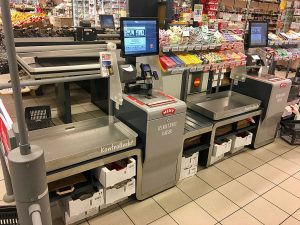
While more of us are ordering our groceries online nowadays, others of us still shop at brick-and-mortar stores. With state governments limiting the number of people in a store, including limiting the number of store personnel, more of us may be using self-checkout systems to pay for our groceries. Before the restrictions implemented to slow the spread of COVID-19, stores were experiencing an increase in customers, and with that, customers were experiencing longer wait times in checkout lines.
With the growth of e-commerce, brick-and-mortar stores are also having to compete with the ease of shopping online, customers checking out their items with the click of a mouse. The stores have a need to increase revenue while decreasing costs. Increased labor costs, a shortage of workers in developed countries, and a consumer preference for personalized shopping experiences have led retailers to install self-checkout systems. These systems allow stores to shift their personnel from the checkout lane to other retail operations such as restocking shelves and helping customers directly.
Today’s market size shows self-checkout system revenue for 2019 and projected for 2027. The systems segment of the market, the hardware itself, accounted for more than 55% of revenue in 2019. The rest comes from the services segment, which includes consulting, implementation, and maintenance services. This segment is expected to experience the fastest growth during this time period. The need for customized software and the need to update or upgrade the software will contribute to this growth.
Self-checkout systems can be cash-based or cashless. Cash-based systems, whether standalone or systems that can be mounted on a shelf, pedestal or wall, had the highest market share in 2019. Consumer preferences for cash transactions along with some cities in the United States banning cashless stores will contribute to growth in this segment. Cashless systems, like what is found in Amazon Go stores, where customers can pick a product, scan it, and pay for it in the aisle using a smartphone app, are expected to experience the fastest growth through 2027. While cash is still the most widely used form of payment in the world, growth in this segment of the industry will be due to the increasing popularity of electronic payments among millennials and middle-aged consumers in addition to the increasing availability of digital payment solutions.
However, not all retail is conducive to cashless self-checkout systems. In 2018, Walmart abandoned a pilot program that tested the technology in many of its stores. Walmart shoppers who tried the service found it awkward to scan a large number of items and found it difficult to scan fresh produce efficiently. As a result, not many customers used this system. High inventory stores with many existing checkout stations, electronics stores which require customer service personnel to help customers with their purchases, and clothing stores in which customers try before they buy, and those same customers may not return items to the shelf or rack if they decide not to purchase them are other examples of businesses where cashless self-checkout systems may not be practical.
Although self-checkout systems may be more convenient for consumers, it also contributes to a rise in the loss rate for stores. Thefts and items not being scanned, whether deliberate or accidental, lead to an average 4% loss rate for retailers who implement self-checkout systems. Newer systems, however, use artificial intelligence to reduce fraud.
By region, North America had the highest market share followed by Europe as more large supermarkets, hypermarkets, and discount chains adopt self-checkout systems. The Asia-Pacific region is expected to be the fastest-growing region for the adoption of self-checkout systems, expanding at a compound annual growth rate of more than 15%. The adoption of cashless self-checkout systems is driving the growth, especially AI-enabled cashless systems in which all products are scanned instantly before the consumer is directed for payment. Worldwide, leading self-checkout system companies include: NCR Corp., Toshiba Global Commerce Solutions, Diebold Nixdorf Inc., FUJITSU, ITAB Group, and ECR Software Corp.
Geographic reference: WorldYear: 2019 and 2027
Market size: $2.8 billion and $7.8 billion, respectively
Sources: “Self-checkout Systems Market Size, Share & Trends Analysis Report by Components (Systems, Services), by Type (Cash Based, Cashless), by Application, by Region, and Segment Forecasts, 2020 – 2027,” Grand View Research Report Summary, April 2020 available online here; “Self-checkout Systems Market Size Worth $7.8 Billion by 2027 | CAGR: 13.3%: Grand View Research, Inc.,” CISION PR Newswire Press Release, April 16, 2020 available online here; “Amazon Go Remains Compelling but Niche Shopping Experience, Finds Strategy Analytics,” BusinessWire, April 21, 2020 available online here; Russell Redmond, “Walmart Pulls Plug on Moblie Express Scan & Go,” Supermarket News, May 17, 2018 available online here; Michael Suswal, “Why Retailers are Abandoning Scan & Go Self-Checkout,” Multichannel Merchant, January 15, 2019 available online here; Paul van der Knaap, Taco de Vries, and Ewout Boesenach, “World Cash Report 2018,” G4S Cash Solutions and Payment Advisory Group, 2018 available online here.
Image source: Wolfmann, “File:Self-service check-out Barcode scanning Payment machine Grocery store (Selvbetjent kasse Skanning Betalingsautomat) Interior etc Meny Supermarket Industrivegen Osøyro Norway 2019-11-28 IMG 6048.jpg,” Wikimedia Commons, November 28, 2019 available online here. This image file is licensed under the Creative Commons Attribution-Share Alike 4.0 International license.
